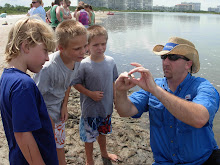Sea foam is created when particulate matter along the seafloor is churned up by incoming wave action and carried ashore. As waves break, air is trapped on the surface and forms bubbles. These bubbles become “agitated” through friction and mixing with the extracted organic material (i.e. proteins, lipids, carbohydrates etc) from the seafloor to form the white, foamy substance we see along the shoreline. In some instances inorganic material also attaches to the surface of the bubbles, and when the foam collapses in on itself, a thin film of gray-colored mud is left behind where ever the foam was deposited along the beach.
Several factors affect the kind and amount of foam present on the beach. Different kinds of particulate matter may be present depending on the time of year, which can affect the make-up of the foam. In warmer months, the source of the organic material might come from different types of phytoplankton, where in winter months the source might be macroalgae such as red drift algae. Intensity of wave action is also an important factor. With normal wave activity only small amounts of foam may be visible along the shoreline if at all. During large storms, however, foam can accumulate in piles several feet thick ,especially when the wind pushes it up against obstacles such as beach escarpments or debris.
Sea foam is usually not thought to be harmful, although there have been cases where birds have become sick by coming in contact with it due to the type harmful algal bloom-producing phytoplankton that made up the foam. There is the possibility of sea foam carrying pollutants, as been shown on freshwater surface foams, but generally, it is not considered to be a problem along beaches. On a positive note, it is thought that sea foam does act as an important source of recycled nutrients for nearby coastal waters.
Enjoy the beach!!
 |
| sea foam along a beach in Southwest Florida |






No comments:
Post a Comment